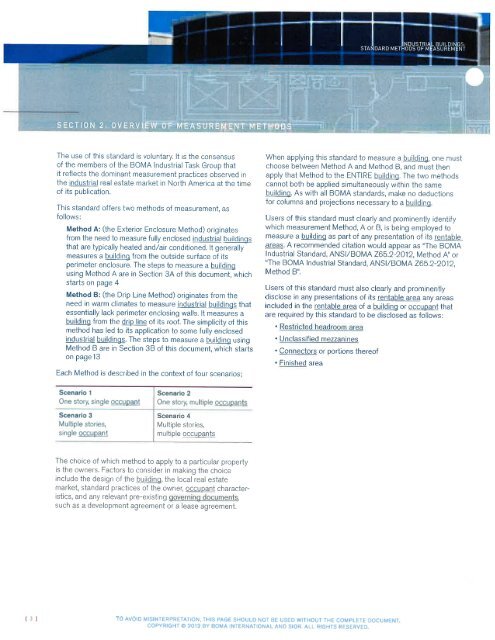BOMA
BOMA_Industrial_Buildings_Standard_Methods_of_Measurements_2016
BOMA_Industrial_Buildings_Standard_Methods_of_Measurements_2016
Create successful ePaper yourself
Turn your PDF publications into a flip-book with our unique Google optimized e-Paper software.
The use of this standard is voluntary, lt is the consensus<br />
of the members of the <strong>BOMA</strong> lndustrial Task Group ihat<br />
it reflects the dominant measurement practices observed in<br />
the industrial real estate market in North America at the time<br />
of its publication.<br />
This standard o{fers two methods of measurement, as<br />
follows:<br />
Method A: (the Exterior Enclosure Meihod) originates<br />
from the need to measure fully enclosed industrial buildings<br />
that are typically heated and/au conditioned, lt generally<br />
measures a building from the outside surface of its<br />
perimeter enclosure. The steps to measure a building<br />
using Method A are in Section 3A of this document, which<br />
starts on page 4<br />
Method B: (the Drip Line Method) originates from the<br />
need in warm climates to measure industrial buildings that<br />
essentially lack perimeter enclosing walls. lt measures a<br />
building from the drip line of its roof. The simplicity of this<br />
method has led to its applicaiion to some fully enclosed<br />
industrial buildings, The steps to measure a building using<br />
Method B are in Section 38 of this document, which starts<br />
on page13<br />
Each Method is described in the context of four scenarios;<br />
When applying this standard to measure a building, one must<br />
choose between Method A and Method B, and must then<br />
apply that Method to the ENTIRE building. The two methods<br />
cannot both be applied simultaneously within the same<br />
building. As with all <strong>BOMA</strong> standards, make no deductions<br />
for columns and projections necessary io a building,<br />
Users of this standard must clearly and prominently identify<br />
which measurement Method, A or B, is being employed to<br />
measure a building as part of any presentation of its rentable<br />
areas, A recommended citation would appear as "The <strong>BOMA</strong><br />
lndustrial Standard, ANSI/<strong>BOMA</strong> 265.2-2012, Method A'or<br />
"The <strong>BOMA</strong> lndustrial Standard, ANSI/<strong>BOMA</strong> 265,2-2012,<br />
Method 8".<br />
Users of this standard must also cleady and prominently<br />
disclose in any presentations of its rentable area any areas<br />
included in the rentable area of a building or occupant that<br />
are required by this standard to be disclosed as follows:<br />
. Restricted headroom area<br />
. Unclassified mezzanines<br />
. Connectors or portions thereof<br />
. Finished area<br />
Scenario 1<br />
One story, single occupant<br />
Scenario 3<br />
Multiple stories,<br />
single occupani<br />
Scenario 2<br />
One story, multiple occupants<br />
Scenario 4<br />
Multiple stories,<br />
muitiple occupants<br />
The choice of which method to apply to a particular properiy<br />
is the owners. Factors to consider in making the choice<br />
include the design o{ the building, the local real estate<br />
market, standard practices of the owner, occupant characteristics,<br />
and any relevant pre-existing governing documenis,<br />
such as a development agreement or a lease agreement.<br />
t31<br />
TO AVOID N4ISINTERPRETATION, THIS PAGE SHOULD NOT BE USED WITHOUT THE COIVPLETE DOCUN/ENT<br />
COPYRIGHT @ 2012 BY BOI\,4A INTERNATIONAL AND SIOR. ALL RIGHTS RESERVED.


